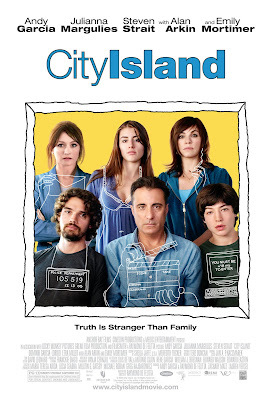Beverly Gray's Blog: Beverly in Movieland, page 25
May 30, 2023
Sunday in the Park Without Stephen
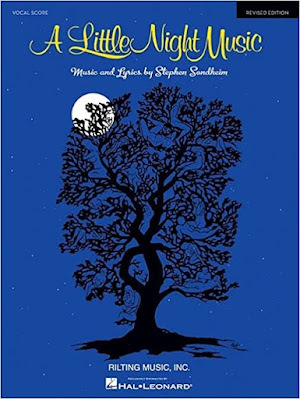
Oh, the joys of a Sondheimmusical! But I’m actually talking about another Stephen. You see, I’m newlyback from a writers’ conference in New York City. On a beautiful Sunday afternoon, I waited in Bryant Park fortwo hours to meet with a fellow writer.Alas, he never showed. (Later I found out he’d been hospitalized. Of course Ihope he gets well soon!)
But Sondheim is much in mymind right now because I’ve just seen a terrific revival of the great man’swaltz operetta, 1973’s A Little Night Music, at the Pasadena Playhouse.What does this have to do with movies? Quite a lot, actually. This complicatedstory of thwarted and consummated love was based by Sondheim and book authorHugh Wheeler on the rare Ingmar Bergman romantic comedy, 1955’s Smiles of a Summer Night. Asin the Bergman film, events transpire on the midsummer evening when, in the Swedish countryside, darkness neverquite comes, but lovers strongly feel the urge to merge. Once Sondheim’smusical version became a worldwide stage hit, Hollywood came calling. Sondheim,a great lover of film, was all for it.
Stage director-producerHarold Prince signed on to direct the 1977 film version, which was distributedby my former boss, Roger Corman, a B-movie guy who in that era was looking to participatein classier projects.
Unfortunately for filmgoers,much of the casting tried a bit too hard for Hollywood pizzazz.. While maleactors like Len Cariou reprised their stage roles, the all-important women’sparts were given to actresses popular with TV and movie fans. That’s why Diana Rigg, wellknown in that era for playing Emma Peel on TV’s The Avengers, was giventhe key supporting role of CountlessCharlotte, the bitter wife of a philandering dragoon. And the leading part,that of a glamorous but ageing actress who has discovered she longs for truelove (and who gets to sing “Send in the Clowns”) went to no one but ElizabethTaylor. I’ve never managed to see the whole movie, which was roundly panned bycritics and shunned by audiences. But the YouTube clip of Taylor stifflytalk-singing through that dazzling song (see below) is easy to ridicule.
A Little Night Music was not the only Hollywood film based on a Sondheimmusical, but it was one of the first. In the Sixties, two Broadway musicals forwhich he’d provided lyrics, West Side Story and Gypsy, became big-budget films, with varying degreesof success. His knockabout musical comedy, A Funny Thing Happened on the Wayto the Forum, became a frenetic Zero Mostel vehicle in 1966. Seven years later, Sondheim—a great fan ofmysteries and word games—collaborated with actor Tony Perkins on the script fora twisty, bitchy non-musical called The Last of Sheila. For WarrenBeatty’s comic-strip spinoff,, Dick Tracy (1990), Sondheim was hired tocontribute five songs. One of then, “Sooner or Later (I Always Get My Man)” wasseductively sung by Madonna, in the role of Breathless Mahoney: it ended upwinning Sondheim his one and only Oscar.
Of the two major Sondheimmusicals that have been made into movies thus far, Sweeney Todd (a 2007 film starring awell-cast Johnny Depp and Helena Bonham Carter) has its moments, notably adeadpan droll “By the Sea,” with a scowling Sweeney on the sand at Brighton,fully dressed in his funereal black suit. An all-star Into the Woods (2014), with Meryl Streep as the Witch, approaches the power of the original. Butfantasy, which works beautifully on stage, is much harder to carry off at themovies.
With best wishes to S.M. Silverman
May 26, 2023
Imitating the Inimitable: the Loss of Loud, Proud Tina Turner
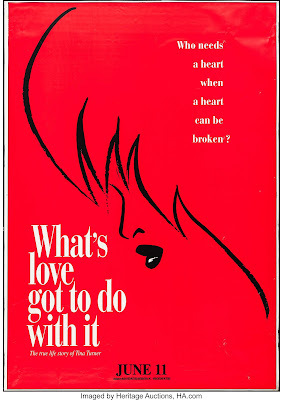
So another icon has left thebuilding. Yesterday’s newspapers brought word that the great Tina Turner had passedaway at age 83. I never saw her performin person, but her recordings and over-the-air performances were plenty toconvince me that as a singer, dancer, and all-around bad ass she was one of akind. To me, and to many others, she will always be “Proud Mary” for real.
Which, of course, is why Hollywoodsnapped up the opportunity to portray her onscreen. In the 1993 biopic, What’sLove Got to Do With It?, Tina was played by Angela Bassett, whileLaurence Fishburne took on the role of Tina’s talented but sometimes ruthlesshusband, Ike. (Both were nominated for Oscars.) Though she criticized the film’s many inaccuracies, Tina herself praisedBassett’s performance, later writing in a 2003 Time magazine tribute to Bassett, “Angela, thefirst time we met, you didn't look, sound, or move like me—that came laterafter you worked so hard to make it happen. But even then, I could see that theyoung woman standing before me had strength, determination, and big, bigdreams, just like me.”
It's rare when the lead actorin a biopic gets that kind of praise from a living subject. Which doesn’t mean,of course, that what Bassett contributed on screen should be confused with thereal thing. We move even further fromreality with Tina, the jukebox musical first seen on stage in London(2018) and then on Broadway ayear later. The show, which I’ve enjoyed, neatly shapes Tina’s chronology as away to work in most of her top songs, using them to explain the various phasesof her life.
So-called jukebox musicalshave been all the rage on Broadway for some years now, giving theatregoers achance to pretend they’ve seen some of the world’s great talents inperson. Not all jukebox musicals set out to tell the performer’s own story: forinstance, Girl From the North Country re-arranges 19 pre-existing songsby Bob Dylan to tell a Depression-era story about the inhabitants of a shabbyDuluth rooming house. But the classic jukebox musical uses a singer’s owncatalogue of hits as a way to narrate the story of his or her showbiz career.I’m thinking of the current MJ: The Musical (about, natch, the life andtimes of Michael Jackson) and A Beautiful Noise: The Neil DiamondMusic (which includes in its cast actors playing Diamond Then and DiamondNow). Beautiful, the musical about songwriter Carole King’s eventfullife, was well-received when it opened in 2014 for a five-year run. There wassomewhat less love for The Cher Show (something of a hodgepodge, withthree different actresses playing Cher as Star, Babe, and Lady). It only stuckaround for 295 performances.
Aside from shows that focuson a single performer, there are several that explore the dynamics of anevolving musical group. Long-ago revues like Ain’t Misbehavin’ and Smokey Joe’s Café paid tribute tosongwriters like Fats Waller and the Leiber/Stoller duo, but didn’t reallyfocus on anyone’s biographical story. More recently, the long-running JerseyBoys intertwined the lives of Frankie Valli and the Four Seasons with theirmusical hits, explaining how four feckless young guys from the Garden Stategrew and changed as they found themselves becoming cultural icons. In a similarspirit, Ain’t Too Proud has drilled in on Motown’s The Temptations.
Is it nostalgia that endearsthese shows to the public? I think we all want to feel that we were truly inthe room where it happened,
May 23, 2023
Secrets and Lies: “City Island”
City Island is anobscure part of the Bronx known fondly as a seaside village full of quaint oldhouses occupied by quaint old families. The clam-diggers, as those born andraised on the island are called, tend to be workaday folks who speak loudly andplainly, with strong New Yawk accents. They don’t, though, always tell thetruth.
Case in point: the Rizzofamily, featured in a well-crafted 2009 indie chockful of flawed but fascinatingpeople. Vince (Andy Garcia) is a prison guard who tells his wife and kids he’soff to a weekly poker game when he’s really in Manhattan taking acting classes.His wife Joyce (Juliana Margulies) is restless and looking for love. DaughterVivian (Dominik Garcia-Londo) has not told the folks at home that she’s droppedout of college and taken up a job that’s perhaps not exactly savory. Teen sonVince Jr. (Ezra Miller) has a secret kink that involves lusting after very fatwomen on the Internet. Everyone is sneaking cigarettes while pretending theydon’t smoke. And there’s one moresecret, involving a handsome young prisoner, that threatens to tear the familyapart . . . but then helps it pull itself back together.
In this cleverly plotteddramedy, Vince’s acting coach (Alan Arkin) becomes a catalyst for all theuntruths to be brought into the light of day. Arkin’s pontificating MichaelMalakov dreams up an exercise in which pairs of would-be actors are required totell one another their deepest, darkest secrets. Vince is paired with Molly(Emily Mortimer), a lively young Brit (or is she?) who encourages his dreamsand listens to his long-concealed guilt about abandoning a baby son. You canguess where he finds that son, now grown.
While dealing with thatdiscovery, Vince is also learning to own up to his passion for following in thefootsteps of his personal hero, Marlon Brando. With Molly’s encouragement, heshows up at an audition “cattle call” for a bit part in a Martin Scorseseflick. (Arkin/ Malakov is also there, pathetically awaiting his own turn to impressthe big boys.) At the audition, Vince is as green as they come, but his ownlife experience, coupled with the canny use of an acting tip he got in anunexpected place, wins him a tiny but dramatic role in Scorsese’s latest urbancrime saga. This becomes a source of pride to a family that could really use abreak.
I don’t know the work ofRaymond De Felitta, who both wrote and directed this little gem. Apparentlyhe’s an actor/writer/director/producer, and a jazz pianist on the side.For his work he’s won big awards atsmall festivals, and his AFI thesis film, Bronx Cheers, nabbed an Oscarnomination for best live action short in 1991. More recently, City Island earnedhim the audience award at the Tribeca Film Festival, and in 2016 he was nominated by the Directors Guild ofAmerica for helming a limited TV series, Madoff. So he’s a working director, and from theglimpse we get of him on the City Island DVD, schmoozing with the film’s actors over pasta and potatoes, he’s an amiable guy,one with a great affection for the ethnic mishmash that is New York. He's also, from what I’veread, a devoted family man. That fact fits the story of City Island, inwhich almost irreparable harms can be overcome by family solidarity and familylove. Kudos to all involved, and especially to Andy Garcia, who believed inthis project to the extent of becoming its producer. We need more like thisone.May 19, 2023
Ronald Colman: A Far Far Better Man?
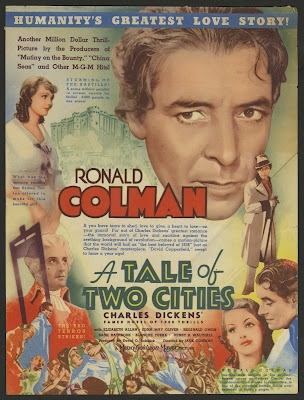
My esteemed colleague CarlRollyson is probably one of the busiest biographers around. While publishingsome thirty-five books, many of them biographies of eminent literary figureslike Faulkner and Sylvia Plath, he is also a retired professor, a book editor,a reviewer, a podcaster, and a chronicler of movieland royalty. I happen toknow that he’s currently deep into a biography of Ronald Colman, the British actor once revered for his mellifluousvoice, his neat mustache and his gentlemanly manner. My parents loved Colman inLost Horizon (1937) and TheLate George Apley (1947). He won an Oscar for A Double Life, also1947. Trying, in my way, to keepup with Carl, I’ve just watched two Colman oldies, Random Harvest (1942)and A Tale of Two Cities (1935).
Random Harvest is based on a popular novel by James Hilton. I have no idea whatthat title means, but it features a British officer who has left thebattlefields of World War I with a serious case of amnesia. There’s a poignantscene, early on, wherein an elderlycouple from the hinterlands arrives at Colman’s British sanitarium,, hoping he’ll turn out to be their missing son. Hehopes so too . . . but he’s not. Desperate to make something of his life, he sneaksout into the local town, and is promptly taken in tow by a lively youngmusic-hall singer (Green Garson). Soon he learns to forget his missing past andforge a new life with her. But wait! Tragedy strikes again! While hurrying to ajob interview he’s hit by a passing taxi . . . and his memories of his pastreturn to him. He now knows he’s the beloved scion of a wealthy family, and theycan’t wait to fold him into their posh existence. That’s fine with him, becausehe’s completely forgotten his marriage to Garson and their happy days in a cozyMidlands cottage. Soon he’s an important figure in the business world. ButGarson, undaunted, signs on as his loyal secretary and waits for him toremember their life together. The plot thickens from there.
Though Colman is fine as thestalwart but confused soldier, the film is really Greer Garson’s. In the novel,the reader doesn’t know that Paula Ridgeway and Margaret Hanson are the sameperson. But this would hardly have worked on film with a face as familiar as Garson’s.So in playing the secretary she conveys a secret yearning that worksbeautifully. (She won an Oscar for that same year’s Mrs. Minniver.) Carol Burnett fans will enjoy her spoof ofthis film, Rancid Harvest (see below).
I was more impressed by Colman’sleading man chops as Sydney Carton in one of David O. Selznick’s literaryadaptations, A Tale of Two Cities. This typically convoluted andschmaltzy Charles Dickens novel about the French Revolution was somehowcondensed by screenwriters W.P Lipscomb and S.N. Behrman (the latter famous forsophisticated comedies) into a brisk two hours. It’s an MGM “cast of thousands”extravaganza, with a horde of extras marching through the streets of a backlotParis to tear down prison walls. (There was a well-deserved Oscar nominationfor editing, as well as one for best picture.) The acting is theatrical, to putit kindly, but Blanche Yurka as Mme. Defarge, crazed with her thirst forrevenge against the “aristos,” stands out. I was surprised at the eventual RogerCorman-style catfight to the death between her and Edna May Oliver as the primMiss Pross, but it’s in the novel. Amid all this, Colman’s tortured andunlikely hero won’t soon be forgotten.
May 16, 2023
Striking Out: The Writers' Guild of America and The Mary Tyler Moore Show
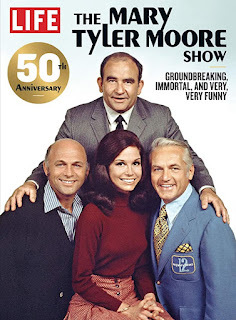
The pandemic introduced me tothe pleasures of vegging out on the couch most evenings to watch the best intelevision. It’s allowed me to catch up, belatedly, on now-classic series like BreakingBad and newer ones like Inventing Anna. But at times I’mlooking for something nostalgic and easy on the eyes. Often the passage of timecreates a disconnect: my once-beloved Carol Burnett Show seems to me nowa bit grotesquely out of date, though its classic movie parodies still give mea chuckle. Still, The Mary Tyler Moore Show (1970-1977) is an amiable,and sometimes hilarious, way to spend 30 minutes with some deeply flawed butlovable characters.
I think of this show, about asingle gal working for a Minneapolis TV news station, as pretty much pureescapism. But a second-season episode (one of the funniest I can recall) remindedme of issues that are in the news right now. It’s all about fallout from awriters’ strike, which briefly decimates the newsroom in which Mary is the GalFriday to curmudgeonly Lou Grant (Edward Asner). Mary and Lou are officiallyManagement, so they must stay behind when their show’s news writers walk offthe job and join the picket lines. Doofus announcer Ted Knight (as Ted Baxter)is dumbfounded by all the issues involved, but his performers’ union requireshim to leave too. So Lou and Mary are put in the position of trying both to writethe news copy and present it on air. It doesn’t work: Mary’s attempt to put abit of drama into a weather story is ridiculously ill-considered, and Lou – ason-air presenter – turns out to have a galloping case of stage fright that onlya lot of scotch will cure. Fortunately the strike only lasts two days, andeveryone lives happily ever after.
Too bad things don’t end soneatly in the real world. Members of the Writers’ Guild of America (who work inboth film and television) are now on strike for real, desperate to improvetheir take-home pay in an era when TV is dominated by streaming services. Incontrast to the big TV networks of old, Netflix and the other streamersnotoriously pay only modest wages to staff writers. Nor do they offer thehealthy residuals on which writers have long counted as a way to shore up amiddle-class lifestyle.
It doesn’t stop there. Asaggrieved writers are quick to point out, studios won’t even discuss anotherelephant in the room: the advent of ChatGPT as a threat to the writingprofession. We all know that writing for movies and TV often tends to rely onwell-known formulas. As pointed out in a recent report in The HollywoodReporter, what’s to stop studio heads from turning to ArtificialIntelligence to plan new episodes of old shows? Said Amy Webb, founder and CEO of something called the Future TodayInstitute, a long-running procedural like Law & Order could easilymake use of ChatGPT for plotting out episodes, then bring in a human writeronly to shape and polish. It’s a possibility that WGA members are desperate tohash out with Management, but Management won’t commit.
As a teacher of screenwritingI know how many “civilians” are out there, hoping to make it as writers inHollywood. But Hollywood professionals know how easy it is to get cheated outof a living wage. My former boss RogerCorman would habitually ask an office drone to throw together a first draftover a weekend, then pay a professional only for a rewrite. Have things changedso very much?
May 12, 2023
Dirt on “The Dirty Dozen”
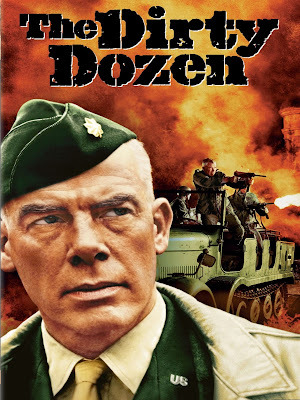
Mycolleague Dwayne Epstein is perhaps the world’s #1 fan of tough-guy Lee Marvin.In 2013, after years of research, he published Lee Marvin: Point Blank.It’s an in-depth tribute to the gruff action star, whose world view was shapedby his combat experience in the Pacific. Now Dwayne has published an in-depthappraisal of one of Marvin’s biggest films, one that topped the box office inthe volatile year 1967. This April saw the release of Dwayne’s Killin’Generals: The Making of The Dirty Dozen, the Most Iconic WWII Movie ofAll Time.
Since I myself have writtenbooks about the movie year 1967, I’ve wrestled with the popularity of thisexciting but disturbing film. I was lucky enough to interview the late E.M.Nathanson, who wrote the best-selling 1965 novel on which the film was based. Dwaynewas lucky too: I shared with him my unpublished transcript of that interview,and in his Acknowledgments he graciously thanks me for my contribution to his book.(Nathanson had praised to me Robert Aldrich’s film adaptation, and particularlyits new climax, in which the ragtag American GIs take a particularly gruesomerevenge on a cluster of Nazi generals and their consorts, saying: “Aldrich hada lot more balls to put that on screen than I did.”)
The Dirty Dozenis a World War II movie with a difference. Major John Reisman, played by Lee Marvin,has been put in charge of twelve dangerous men. They’re a motley bunch, comingin many shapes and colors, but all of them are American soldiers who’ve beenconvicted of criminal offenses, including rape and murder. With D-Day fastapproaching, Reisman’s mission is to whip these felons into shape, then takethem far behind enemy lines for a daring assault on a German stronghold.
Through finding its heroesamong hardened outlaws and criminals, the film taps into a late Sixtiesinclination to challenge authority. Still, TheDirty Dozen, vigorously directed by Aldrich, is in many ways a glossy and old-fashioned war movie. The men’scrimes are mostly explained away, or quickly forgotten. A training segment (inwhich they discover group solidarity and earn their nickname by jointlyrefusing to shave) is played chiefly for laughs. So is an extended war-gamessequence in which the Dozen use dirty tricks to stymie the pompous militarybrass, thus earning the sympathy of every viewer who’d ever butted heads withwhat the Sixties called the Establishment. By the film’s climax, when the toneturns deadly serious, virtually all of Reisman’s men come through in theclutch. Once they reach the chateau that harbors a large contingent of Germanofficers, only one of them reverts to being the sociopath he once was. Thefilmmakers have taken several of the novel’s hardest cases—a rapist, a racist,and a pervert—and rolled them into a single character. True to the spirit ofthe Sixties, with its deep-seated commitment to civil rights, it is theSouthern racist (played by the very unlikely Greek-American Telly Savalas) whoproves to be beyond redemption. The others, under Reisman’s canny leadership,join forces to do their job bravely and well. Most of them end up laying downtheir lives for the Allied cause. Patriotic music swells as the mission’s fewsurvivors are given military commendations, and a solemn voiceover tells usthat the fallen men “lost their lives in the line of duty.”
What message is The Dirty Dozen sending? Critics of theday vigorously debated what Aldrich was saying about the nature of war. I’llleave it to Dwayne Epstein to sort it all out.
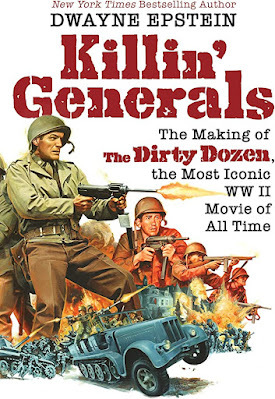
May 9, 2023
Mrs. Brown, You’ve Got a Lovely Kingdom
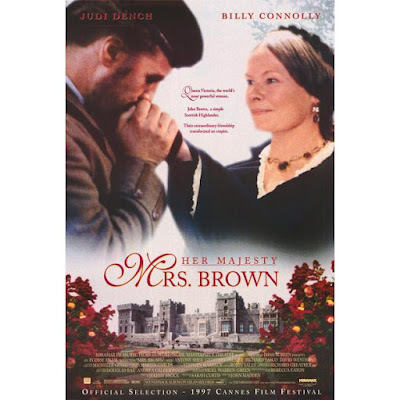
King Charles’ coronation lastSaturday brought out the Anglophile part of me that’s fascinated by the Britishmonarchy, its triumphs and its troubles. Queen Victoria had never been aparticular favorite of mine—she has always seemed stuffy and dull—but a recentvisit to Kensington Palace that featured an exhibit on her difficult girlhoodshowed me she was more interesting, and much stronger, than I had expected. So,as my own idiosyncratic way of celebrating the formal installation of the newking, I watched a 1997 British drama called Mrs. Brown (also known as HerMajesty, Mrs. Brown) that details a surprising relationship in Victoria’slater life It is not to be confused with Victoria & Abdul(2017), about the elderly queen’srelationship with a male Indian Muslim servant. Obviously if you’re a woman whofrom 1837 to 1901 has ruled over the most powerful empire on earth, you havetime for a good many surprising relationships.
In both Mrs. Brown andVictoria & Albert, the role of the queen is taken by the formidableJudi Dench, who has made something of a specialty of playing regal types. Shewon her Oscar in 1998 for playing Elizabeth I in Shakespeare in Love, ina role that was scarcely eight minutes long. Remarkably, she was convincing asthe imperious Virgin Queen despite looking in no way similar to the tall, slimElizabeth. But I suspect that physically Victoria much better suits her petite,slightly plump frame. Her performance in Mrs. Brown too was muchadmired, leading to her first Oscar nomination: there have been eight in all.
Playing opposite her is BillyConnolly, a Scottish actor once known for his raw stand-up comedy chops. Hisrough-and-tumble role is that of John Brown, a Scotsman who had once tended thehorses for Victoria’s beloved late husband, Albert. Following the early deathof Albert at age 42, Victoria has retreated to Scotland to mourn, presidingover a retinue of servants and hangers-on while turning her back on any royalduties. It is as part of a pact to lure her back to public life that Connollyis brought into her sphere. He makes quite a sight among the black-cladcourtiers, wearing a kilt and his hair in a pigtail. Her royal highness firsttolerates him because of Albert’s fondness for him, but then quickly succumbsto his blustering, bantering ways. Soon they are riding out in the highlands, andleading the dancing in Balmoral’s ancient halls. There’s no suggestion in thefilm that theirs is a romantic (o, heaven forfend, a sexual) relationship, butrather a deeply affectionate friendship that bypasses the difference in theirpublic status.
It's clear to see thatVictoria enjoys this respite from her public obligations and this distractionfrom her private grief. Brown’s motives can more easily be questioned. Assomeone who came to the British throne before she was 20, Victoria obviouslyrevels in the chance to be girlish. As for Brown, the film shows that his roleat her side feeds an already healthy ego: he certainly takes the opportunity tolord it over the others who dwell in the servants’ hall. Still, there seems a selflessnessin his loyalty to his sovereign. He makes a mistake or two, but surely seems tohave her best interests at heart. Eventually, of course, his role in her life comes under publicscrutiny. When it gives rise to satirical cartoons and jests about “Mrs.Brown,” thus threatening her reputation in Parliament and encouragingrepublican moves against the monarchy, he knows where his duty lies.
May 5, 2023
Two Women: “Wanda” and “Iris”

By happenstance I recentlysaw two old films named after their leading female characters. It’s always refreshing for me to watch amovie with a female focus. But Wanda and Iris couldn’t be moredifferent.
Wanda, from 1970, has nothing to do with a fish. (I lovedthe zany British black comedy, A Fish Called Wanda, which came out in1988, featuring members of the Monty Python crew and a pre-Oscar Jamie LeeCurtis) It is instead an ambitiousindie, written and directed by Barbara Loden, an actress who had famously playedthe Marilyn Monroe role in Arthur Miller’s semi-autobiographical After theFall at Lincoln Center. The play had been directed by the great Elia Kazan,who mentored Loden and subsequently married her in 1966.
Despite her years as an actressand a glamorous New York model, Loden understood from her own upbringing how awoman can be vulnerable to self-doubt and male manipulation. That’s why shechose to feature in her film-directing debut a blue-collar young woman fromsmall-town Pennsylvania whose fundamental passivity makes her easy prey forconniving men. Immediately following her divorce (she arrives in court late, withher hair full of rollers) and the loss of all her cash, Wanda ends up in bedwith a violent small-time crook who initiates her into a life of crime. This ishardly Bonnie and Clyde, in which a n attractive young woman discoversself-expression by learning to knock off banks. Wanda (convincingly played byLoden herself) is terrified, but lives for her man’s faint praise when shefollows his lead.
Despite its title character’sdependence on male approval, Wanda is considered a pre-feminist landmark,parly because it’s the rare film of its era made by a woman. It’s a straight-forwardcharacter study that knows how to put its limited resources on the screen. Uponrelease, it won an award at the prestigious Venice Film Festival. Years later,it was lovingly restored by the UCLA Film & Television Archive, and in 2017was inducted into the National Film Registry of the Library of Congress. ThoughLoden next planned a cinematic version of Kate Chopin’s The Awakening, shesuccumbed to cancer at age 46.
In contrast to Wanda,with its unsung heroine, Iris (2001) is about a very famous womanindeed: the much-honored British novelist Iris Murdoch. I’m often annoyed byfilms that hop around in time, but this one justifies its complicated structureby playing the college-age Iris (Kate Winslet) off against her elder self (JudiDench). The youthful Iris is vibrant, reckless, and intensely sexual; her oldercounterpart is a revered public figure, until she starts succumbing to theravages of Alzheimer’s disease. Thus we cut from young Iris blissfullyocean-swimming in the nude to the old one recoiling in terror from the sea.Both actresses have been lauded for their performances, but equally impressiveare Hugh Bonneville and Jim Broadbent, who play Iris’s ever-loyalswain-turned-husband, a scholar named John Bayley. Broadbent was to win awell-deserved Oscar in his supporting role. The film is based on the memoir Bayleypublished after Iris’s death, and one of its central strands is the ordeal ofwatching someone you love disintegrate before your eyes into a person you don’tknow.
The British film industry isso good at exploring complicated lives. Having seen this intelligent,beautifully conceived film, I’m eager to spend more time with Murdoch’sfiction. But the exploration of her lapse into dementia also remind me, oh sopainfully, of my grandmother’s similar decline. Is Alzheimer’s the cruelestdisease of them all?
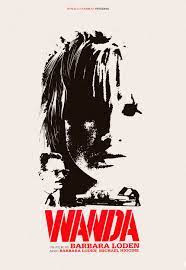 .
.May 2, 2023
East Side Story: “Dead End”

Humphrey Bogart wasn’t alwaysa tough but tender good guy. In his early films he was a tough-as-nails badguy, one whose rare moments of sentimentality only bamboozled him into actionsthat were all the more depraved. One of those early films, Dead End (1937)was adapted by Lillian Hellman from Sidney Kingsley’s 1935 hit Broadway play.Thankfully, I wasn’t around in that era, but I find it hard to imagine Broadwayfirst-nighters dressing up to watch a play that spelled out the squalor ofneighborhoods located very close to their own. Dead End is set inmidtown Manhattan, on the shore of the scummy East River, when luxury residenceswere just starting to replace decrepit tenement flats. When I saw a misguidedrevival at L.A.’s Ahmanson Theatre a decade or two ago, the orchestra pit wasactually filled with water, so that the neighborhood urchins could splash andcavort in the river that plays a major role in the story.
It's a story of rich andpoor: the snooty newcomers with their maids and butlers and well-pressedclothes, set against the downtrodden working-class folks who can’t find away out of their shabby surroundings. Apampered young rich boy is easy prey for the gang of scruffy amoral kids whoroam the streets, looking to make mischief. The wild card in all this is Bogartas “Baby Face” Martin, a tough guy who grew to manhood in this neighborhood.Now a successful mobster decked out in fancy threads, he lives far away, buthas made a sentimental journey back home to visit his old mother and hisonce-upon-a-time sweetheart. It is not a good decision: for one thing, hismother wishes he were dead. As for the one-time sweetheart (the Oscar-nominatedClaire Trevor), she’s pleased to see him . . . but it soon becomes clear that thesedays she’s working the streets, and she’s dying of something unmentionable.
Furious about the day’s twindisappointments, Martin becomes determined to make his NYC trip pay off bystaging a heinous crime. Because, in that Production Code era, criminals mustalways come to a bad end, it is easy to guess that his dastardly deed won’t gounpunished. The hero is a rather bland (as well as blond) good guy played byJoel McCrea, a would-be architect who can’t manage to free himself from histenement roots. He fancies himself in love with a vapid blond who won’t committo him because she can’t shake free of her expensive tastes. McCrea’s characterdoesn’t seem to realize that a far better choice would be Drina (top-billedSylvia Sidney), a poor but honest slum-dweller who has always been his friend.When not slaving in the garment trade (or going out on the picket line), shedevotes herself to a younger brother now being pursued by the law.
A note about Sylvia Sidney:she was born in the Bronx to immigrant parents. In 1926 she had her first filmrole, as an extra in one of D.W. Griffith’s epics. She was a well-paid star inthe 1930s, often playing the sister or girlfriend of a gangster. Her careerfaded in the next decade, but she was still around in 1973 to be nominated fora Best Supporting Actress Oscar for Summer Wishes, Winter Dreams. At theend of her life she had key roles in two films by Tim Burton, Beetlejuice (1988)and Mars Attacks!(1996). Hooray for persistence!
As for Bogart, he of course movedon from bad guy parts to roles that let him stay alive at end of the last reel.
April 27, 2023
The Cat Came Back: “Harry and Tonto”
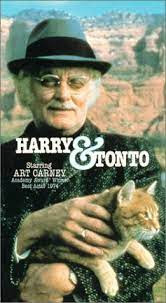
Hard to believe that ArtCarney, best known for playing Ralph Kramden’s blue-collar buddy on TV’s TheHoneymooners, beat out some ofHollywood’s finest for the Best Actor Oscar of 1975. His competition? JackNicholson for Chinatown, Al Pacino for The Godfather, Part II,and such also-rans as Dustin Hoffman (playing Lenny Bruce) and Albert Finney(as Hercule Poirot in Murder on the Orient Express). Roman Polanski’s Chinatownnabbed eleven Oscar nominations that year, though it won only for RobertTowne’s scintillating screenplay. It had the misfortune of being up againstFrancis Ford Coppola’s Godfather sequel, which won five statuettes,including Best Picture, out of a possible eleven. By contrast, Carney’s Harryand Tonto was nominated only for its original screenplay and for Carney’sperformance.
The win for Carney came as asurprise to many, including my former boss Roger Corman, who was reveling inthe fact that so many of his B-movie alumni (including Nicholson, Coppola, andTowne) were nominees that year. He was quoted as joking that Nicholson’s losshad spoiled his personal sweep. It’scertainly possible that Nicholson and Pacino, both playing intensely dramaticroles, cancelled each other out in the voting. But Carney’s victory alsoindicates the Academy’s affection for the fifty-plus-year-old veteran, despitethe rise of a generation of Young Turks.
As a film, Harry and Tontoisn’t much. Directed and co-written by Paul Mazursky, it’s one of histypically modest offerings (see also Bob & Carol & Ted & Alice,An Unmarried Woman, and Moscow on the Hudson) that take up atimely topic and treat it in a low-key manner. In Harry and Tonto, thesubject is the plight of the elderly. Harry, a rather dapper retired schoolteacherwhose wife died years before, is being thrown out of his New York apartmentbecause the building is being “improved” into a parking lot. With his gingercat in tow, he is taken in by a son in the suburbs, but is well aware he'sdisrupting a family already near its breaking point. The bulk of the film ishis odyssey first to Chicago (and a daughter with whom he can’t help sparring)and then to Los Angeles (where his youngest son is overtly needy). There areinteresting stops along the way, including a visit to a first love now in thethroes of dementia, and he connects while on the road with some colorfulcharacters, like the good-hearted fifteen-year-old runaway played by MelanieMayron. But basically the film is on Carney’s shoulders. By the end of Harryand Tonto, we know him well: his gruffness, his surprising erudition, hisquiet live-and-let-live generosity of spirit, his overriding desire not to bebeholden to the younger generation.
It’s not a long movie, but itIS a slow one, and some critics have complained about its pacing. Personally, Iadmit to getting restless . . . but itwas worth it to see (pleasant surprise!) Harry finally find happiness on hisown terms. I had dreaded watching a film in which theelderly are made to look both creaky and cute, and I’m happy that Harry isportrayed as very much his own man, still smart, and without a shred ofself-pity. Stand-outs in a stellar cast include Ellen Burstyn as Harry’sdaughter (she won her own Oscar in 1975 for Alice Doesn’t Live Here Anymore)and Larry Hagman as his younger son. I particularly liked Chief Dan George, asa philosophical Native American whom Harry meets in jail.
And then there’s Tonto thecat, who fittingly won the Patsy Award as the year’s best animal actor.
Beverly in Movieland
- Beverly Gray's profile
- 10 followers


